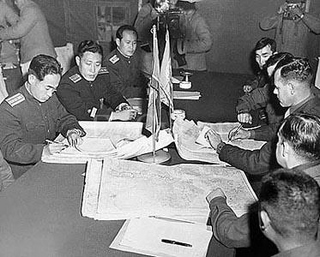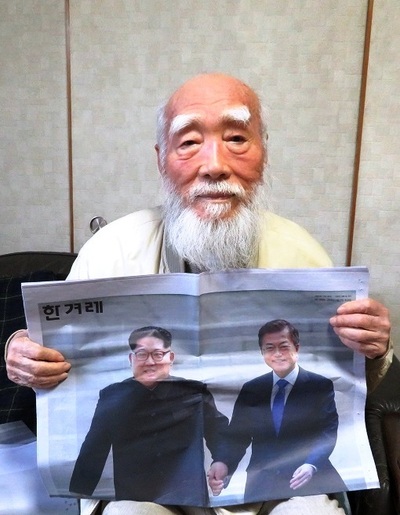Posted on : Jun.13,2018 15:17 KST
Modified on : Jun.13,2018 15:25 KST
Jeong Gyeong-mo was an interpreter during the Korean War armistice talks of 1951-53
“Today is the first time I have really felt like the Korean War is coming to an end. The Japanese occupation was a dark time when it seemed as though colonial rule would last forever, but I have never doubted for a second that this ridiculous war would someday end and the day of peace would come to the Korean Peninsula.”
The voice of Jeong Gyeong-mo, a unification activist living in Japan, quivered on the other end of the telephone line as he spoke about witnessing the handshake between the North Korean and the US leaders on June 12, 68 years after the Korean War began. Jeong, who turns 94 this year, may have been moved more than anyone – being the only surviving witness to South and North Korea’s cease-fire talks at Panmunjeom, where he served as an interpreter for the Allied Forces between 1951 and 1953.
“I was studying in the US in late October 1950 when I was summoned to report to [Douglas] MacArthur’s command in Tokyo, and I was sent to Panmunjeom after the armistice talks began in October the following year,” he recalled.
 |
|
Col. James Murray (right) of the US Marine Corps and Col. Chang Chun-san (left) of the North Korean People’s Army discuss the inter-Korean border while looking at maps of the DMZ’s Military Demarcation Line (MDL) on Oct. 11, 1951, at Panmunejeom. (Hankyoreh archives)
|
“The representatives there were General Nam Il from the [North Korean] People’s Army, General Deng Hua from the Chinese Army, and Navy Vice Admiral [C. Turner] Joy from the UN Forces,” he explained.
“Because President Rhee Syng-man opposed the very idea of cease-fire talks, the South Korean Army had only one observer and one liaison officer present,” he added.
“The two sides’ discussions were about where the armistice line would be set and the issue of exchanging POWs, and I had to be there several times while surveying technicians from the US and Chinese military were using compasses and triangle rules to divide the Korean Peninsula up into South and North. It was so painful watching my homeland being split apart – like witnessing a member of my family being vivisected.”
This account is from a 2009 Hankyoreh series titled “Finding the Way: Memories,” in which Jeong wrote about his experience as an interpreter during the cease-fire talks.
“In Western medieval history, they talk about the Hundred Years War between England And France as the longest and most persistent war, but the rivalry between North Korea and the US on our territory today has now lasted for over 70 years,” he declared. “The time has come for it to end.”
 |
|
Jeong Gyeong-mo, an activist with the Korean unification movement residing in Yokohama, Japan, holds up the Apr. 28 edition of The Hankyoreh depicting South Korean President Moon Jae-in and North Korean leader holding hands at the Apr. 27 Inter-Korean Summit. (provided by Jeong Gyeong-mo)
|
Declaring it his “life’s mission to end the war and conflict on the Korean Peninsula,” Jeong said, “It feels like I have lived this long for a reason as a witness to the cease-fire who has lived long enough to see the war end in my lifetime.”
Jeong also said he had been watching North Korean leader Kim Jong-un closely since his first formal appearance to the outside world at an Apr. 27 inter-Korean summit.
“With his vigorous look, he was very similar to his grandfather Kim Il-sung, whom I met visiting North Korea with Rev. Moon Ik-hwan in Mar. 1989,” he said. “He is young, but I could sense his bold ideas.”
By Kim Kyung-ae, senior staff writer
Please direct comments or questions to [english@hani.co.kr]










